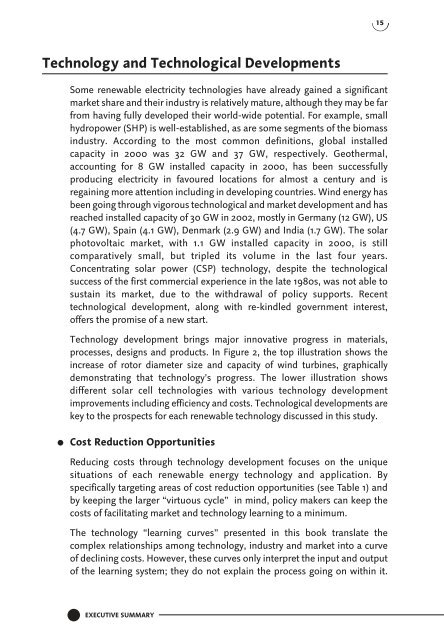Technology Status - NET Nowak Energie & Technologie AG
Technology Status - NET Nowak Energie & Technologie AG
Technology Status - NET Nowak Energie & Technologie AG
You also want an ePaper? Increase the reach of your titles
YUMPU automatically turns print PDFs into web optimized ePapers that Google loves.
<strong>Technology</strong> and Technological Developments<br />
Some renewable electricity technologies have already gained a significant<br />
market share and their industry is relatively mature, although they may be far<br />
from having fully developed their world-wide potential. For example, small<br />
hydropower (SHP) is well-established, as are some segments of the biomass<br />
industry. According to the most common definitions, global installed<br />
capacity in 2000 was 32 GW and 37 GW, respectively. Geothermal,<br />
accounting for 8 GW installed capacity in 2000, has been successfully<br />
producing electricity in favoured locations for almost a century and is<br />
regaining more attention including in developing countries. Wind energy has<br />
been going through vigorous technological and market development and has<br />
reached installed capacity of 30 GW in 2002, mostly in Germany (12 GW), US<br />
(4.7 GW), Spain (4.1 GW), Denmark (2.9 GW) and India (1.7 GW). The solar<br />
photovoltaic market, with 1.1 GW installed capacity in 2000, is still<br />
comparatively small, but tripled its volume in the last four years.<br />
Concentrating solar power (CSP) technology, despite the technological<br />
success of the first commercial experience in the late 1980s, was not able to<br />
sustain its market, due to the withdrawal of policy supports. Recent<br />
technological development, along with re-kindled government interest,<br />
offers the promise of a new start.<br />
<strong>Technology</strong> development brings major innovative progress in materials,<br />
processes, designs and products. In Figure 2, the top illustration shows the<br />
increase of rotor diameter size and capacity of wind turbines, graphically<br />
demonstrating that technology’s progress. The lower illustration shows<br />
different solar cell technologies with various technology development<br />
improvements including efficiency and costs. Technological developments are<br />
key to the prospects for each renewable technology discussed in this study.<br />
● Cost Reduction Opportunities<br />
Reducing costs through technology development focuses on the unique<br />
situations of each renewable energy technology and application. By<br />
specifically targeting areas of cost reduction opportunities (see Table 1) and<br />
by keeping the larger “virtuous cycle” in mind, policy makers can keep the<br />
costs of facilitating market and technology learning to a minimum.<br />
The technology “learning curves” presented in this book translate the<br />
complex relationships among technology, industry and market into a curve<br />
of declining costs. However, these curves only interpret the input and output<br />
of the learning system; they do not explain the process going on within it.<br />
EXECUTIVE SUMMARY<br />
15







